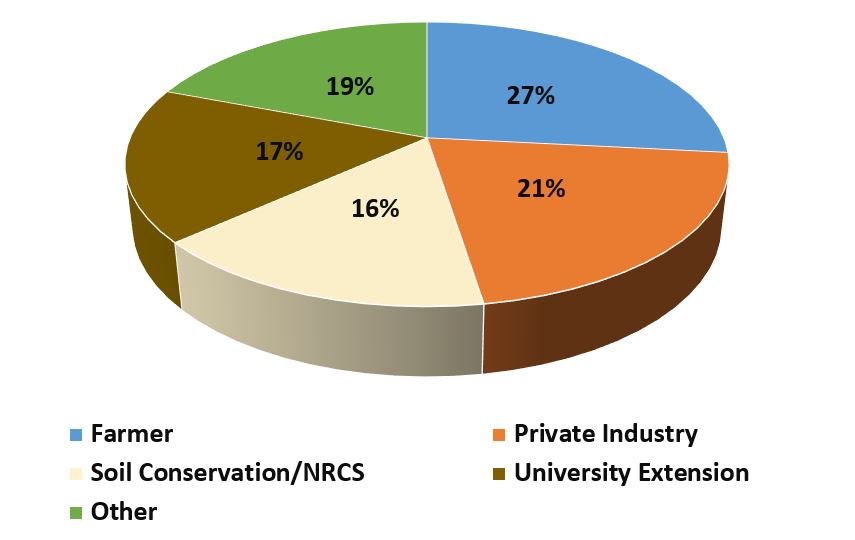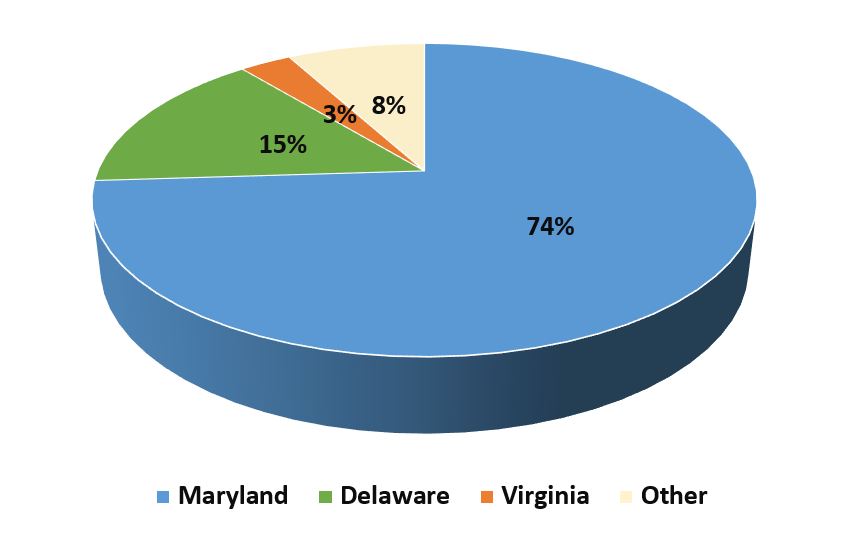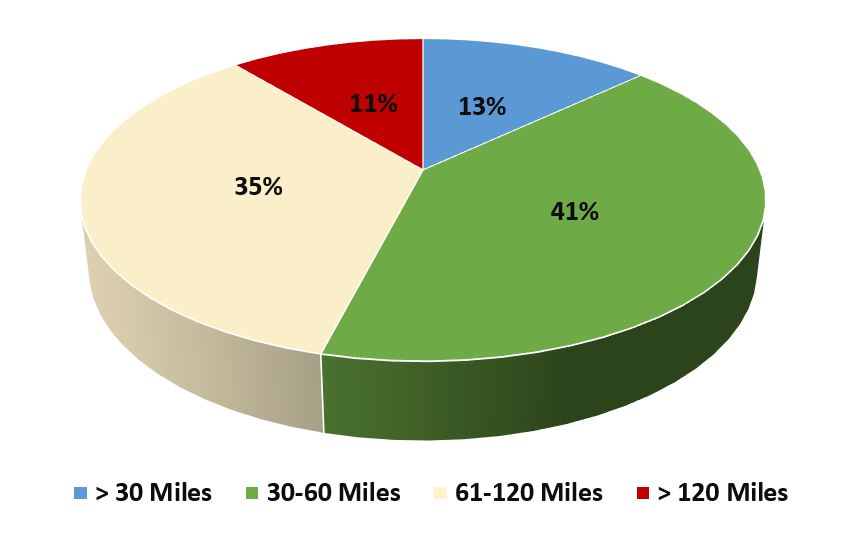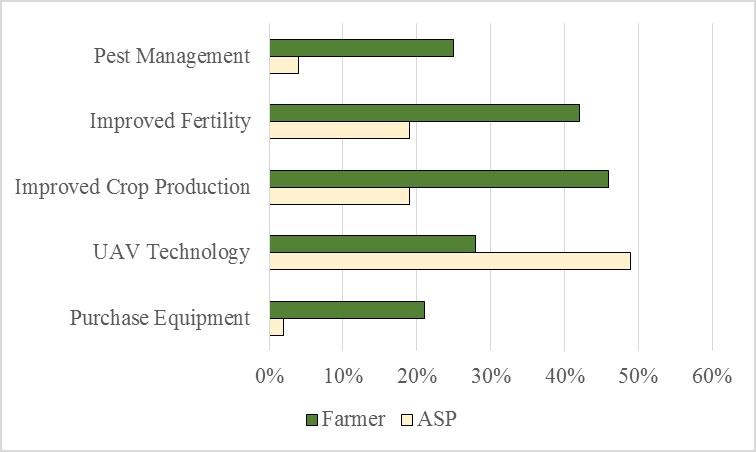Journal of the NACAA
ISSN 2158-9429
Volume 9, Issue 1 - June, 2016
An Annual Precision Agriculture Field Day on the Delmarva
- Miller, J. O., Agent, Agriculture And Natural Resources, University Of Maryland Extension
Dill, S., Principal Agent, Agriculture and Natural Resources, University of Maryland Extension
Rhodes, J., Senior Agent, Agriculture and Natural Resources, University of Maryland Extension
Fiorellino, N., Post-Doctoral Associate, University of Maryland, Dept of Environmental Science and Technology
McGrath, J., Associate Professor and Extension Specialist, University of Kentucky
ABSTRACT
Mid-Atlantic Precision Agriculture Equipment Field Day has been held annually on the Delmarva (Delaware, Maryland and Virginia) Peninsula since 2011, attracting 200-300 attendees. This field day was developed to provide impartial advice about precision agricultural equipment for grain and livestock producers, as well as agricultural service providers. Talks and demonstrations have included section control, variable rate planting, and unmanned aerial systems. A survey was provided in 2014 and 2015 to measure knowledge gain at the event. Farmers who attended had a lower use of precision agriculture methods than agricultural service providers. Both groups reported gaining knowledge in unmanned aerial systems (UAS), precision agriculture technologies and data usage.
Introduction
There is a continuing need for education in precision agriculture practices and methodology (Kitchen, Snyder, Franzen & Wiebold, 2002; Diekmann & Batte, 2010). This is in part due to the steady modifications in technology as well as the training necessary for processing data and using the equipment (Kitchen et al., 2002; Diekmann & Batte, 2010; Mulla, 2013). Adoption of precision agriculture practices has been shown to be influenced by access to information, which can be overcome through Extension education programs (Kitchen et al., 2002).
Those who may be interested in educational programs for precision agriculture are most likely to be younger, possess college degrees and have greater farm income (Diekmann & Batte, 2010; Walton et al., 2008). They are also more likely to be grain producers, as those with livestock report a lower use of precision agriculture technology (Diekmann & Batte, 2010).
For those who already practice precision agriculture, barriers remain due to cost and time (Diekmann & Batte, 2010), which can be remedied by providing knowledge about the value (implied and dollar) of these practices (Kitchen et al., 2002). Extension educators can contribute materials, workshops, and field days, but must also remain updated themselves (Kitchen et al., 2002). With precision agriculture expected to impact agribusiness jobs and opportunities in the future, there is a need to educate both producers and agricultural service providers (ASP’s); (Mulla, 2013). Field days can be an important educational tool, as farmers in Ohio have ranked field days as one of the top three means for obtaining precision agriculture education, behind personal experience and equipment companies (Diekmann & Batte, 2010).
Started in 2011, Mid Atlantic Precision Agriculture Equipment Day (PAD) has become an annual summer event, with its priority as an educational program for farmers and ASPs. Currently, it is held on the Delmarva Peninsula, a region comprised of Delaware, Maryland, and Virginia. Speakers are invited from land grant institutions and regional agribusinesses. Since 2011, talks have covered sprayer and planter technology, global positioning systems (GPS) and real time kinematic (RTK) discussion, as well as data management and UAS.
The program is designed to be an impartial discussion of the use and methodology behind precision agriculture technologies and data analysis. Vendors/sponsors from the industry are offered the opportunity to display the equipment of their choice, including global positioning systems (GPS) guided tractors and sprayers. Demonstrations of unmanned aerial technology have also been performed by the University Of Maryland James Clark School of Engineering. A survey was conducted following the 2014 and 2015 events to measure the impact of the education provided.
Materials and Methods
This field day has been held each year at an outdoor location on the Delmarva Peninsula. The location is typically within driving distance of several other Mid-Atlantic States, including New Jersey, Pennsylvania and West Virginia. The Delmarva is dominated by grain and poultry farming, however dairy, beef and swine operations are located within driving distance in surrounding region. Since 2011, several University Extension groups have been involved in planning and setup including: University of Delaware; Virginia Tech; West Virginia University; Pennsylvania State University; and University of Maryland.
Precision Agriculture Equipment Day has been held four times in the central area of the peninsula (Queen Anne’s and Caroline County, Maryland) and once in the southern region of the peninsula (Somerset County, Maryland). Locations were chosen for their ability to service the region’s farmers, as well as accommodations for large equipment and educational talks.
In its inaugural year, PAD covered an array of topics including equipment settings and maintenance (section control, variable rate, GPS position), as well as discussions on data management and precision soil sampling methods. More recently, topics like UAS have also been addressed. Speakers for these topics were chosen from a nationwide pool of experts from Land Grant universities. Each speaker was invited to choose their own topic from their expertise or address one of the topics identified by the program organizers. Speakers are also invited from regional agricultural service providers to obtain a local perspective. This event has been fully funded by local agricultural businesses.
A farmer panel has been included each year and is a successful part of the program. It provides a very practical view and gives the audience a chance to ask more questions. In 2012, two buildings were utilized so that multiple talks could be presented simultaneously and all talks were repeated in the morning and afternoon. Other year’s talks were given once in a linear program. This event is not static but meant to change and adapt to upcoming technologies, as well as access to space and speakers. Nutrient management, pesticide recertification, and certified crop advisor continuing education credits are provided to attendees according to speaker topic for the surrounding states.
In 2014 and 2015, University of Maryland Extension conducted an Institutional Review Board (IRB) approved survey of participants. This survey was emailed as a link to attendees who provided their email through online registration. Additional emails were obtained for attendees who registered at the door. Out of 361 emails sent over 133 surveys were completed, for a response rate of 37%. Question topics included general demographics, profitability, and educational value and were either Likert, multiple choice, or yes/no in format. The survey was conducted through Qualitrics (Provo, UT), an online data collection software that allows for research and analysis of survey responses. To simplify the discussion of outcomes and impacts, survey results from 2014 and 2015 were combined. To examine farmers ASPs separately, filters were used based on the answers to questions about occupation and part time farming. Some example questions include: 1) Please describe why you attended PAD, 2)How would you rate the day overall, 3) What information or practices do you plan to implement as as result of attending PAD, 4) What is your understanding of the following topics after attending PAD.
Results and Discussion
Who Attended PAD?
Farmers were the majority of respondents (27%, Figure 1), followed by representatives from private industry (21%), soil conservation/NRCS (16%), and Extension (17%). Because respondents were able to select multiple occupations on the survey, there was some overlap in those categories. All of the attendees were part of the targeted audience, although it would be preferable to have a larger number of farmers. It is equally important to educate private industry (agribusinesses) and government employees on the technical and practical uses of precision agriculture equipment.
Over 70% of the respondents were from Maryland (Figure 2), while the rest traveled from Delaware (11%), Virginia (3%), or other states (8%). Respondents reported they would be willing to travel 30 to 120 miles (Figure 2) to participate in PAD. It is not surprising that most respondents reported as being from Maryland and Delaware, as the Delmarva Peninsula is mostly comprised of those two states.
Figure 1. Who attended PAD (% of 133 respondents) in 2014 and 2015.
Figure 2. State of residence for PAD attendees (132 responding) in 2014 and 2015.
Figure 3. Distance attendees would travel to PAD (132 responding).
When usage of precision agriculture methods were cross tabulated (a comparison function in Qualtrics) with occupation, farmers remained on the low use end of the spectrum (Table 1). However, private industry, soil conservation/NRCS, and extension all reported very high usage of precision agriculture practices. Because there was overlap in occupations, farmers and ASPs were separated to understand why there was such a large gap in use and how PAD benefited each group.
| Farmer | Industry | SCD/NRCS | Extension | Other | |
| # Responding | |||||
| Low | 16 | 3 | 4 | 5 | 7 |
| Medium | 13 | 5 | 3 | 3 | 3 |
| High | 9 | 1 | 1 | 1 | 2 |
| Very High | 5 | 16 | 12 | 14 | 11 |
Farmer Demographics and Response
Of the farmers who attended the event in 2014-2015 (Table 2), the majority (70 %) described themselves as full time. This explains why these farmers also identified themselves as working in private industry, soil conservation/NRCS, or extension (each one between 17 to 20%). For those who identified as “other”, the state Department of Agriculture was the top written in response. Farmers at PAD reported tilling between 101-500 acres (39%, Table 3) followed by 1-10 acres (25%). Of those with farming as a primary occupation, 38% had been farming for more than 20 years, followed in order by 11-20, 6-10 and 1-5 years (all between 5-8% of attendees). The most common operation type reported (Table 3) was field crops (70%), followed by fruits/vegetables (21%) and livestock (24%). It should be noted that those surveyed were allowed to pick more than one farm type.
| Farming Type | % |
| Full Time | 70 |
| Part Time | 30 |
| Part Time Occupations | |
| Industry | 17 |
| Soil Conservation/NRCS | 17 |
| Extension | 20 |
| Other | 21 |
| Acres | % | Years Farming | % | Operation Type | % |
| 0-10 | 25 | < 1 | 0 | Field Crops | 70 |
| 11-50 | 8 | 1-5 | 5 | Fruit/Vegetable | 21 |
| 51-100 | 13 | 6-10 | 8 | Livestock | 24 |
| 101-500 | 39 | 11-20 | 9 | Poultry | 3 |
| 501-1000 | 6 | > 20 | 38 | Greenhouse | 5 |
| 1001-2000 | 9 | Not Applicable | 40 | Ornamentals | 13 |
| >2001 | 0 | Other | 12 |
The majority of all farmers (Table 4) were both male (86%) and white (92%), as well as being 45-64 years old (Table 3). Over 50% were college graduates, with 12% having a Master’s degree and 5% with a doctorate. The age of farmers may be correlated to their use of precision agriculture, as only 28% reported a very high usage. However, at least 69% of farmers had a moderate use of precision agriculture technology (moderate, high and very high), which may be related to their college education.
| Ethnicity | Age (Years) | Education | ||||||
| FM | ASP's | FM | ASP's | FM | ASP's | |||
| % | % | % | ||||||
| White | 92 | 92 | < 25 | 8 | 9 | High School/GED | 15 | 5 |
| Black/African American | 2 | 2 | 25-34 | 18 | 17 | Some College | 17 | 5 |
| Asian/Pacific Islander | 1 | 0 | 35-44 | 14 | 23 | College | 52 | 55 |
| Hispanic/Latino | 2 | 1 | 45-54 | 24 | 20 | Masters | 12 | 28 |
| Other | 3 | 2 | 55-64 | 26 | 25 | Doctorate | 5 | 8 |
| >64 | 11 | 5 | ||||||
Farmers rated PAD as either good (53%) or excellent (32%) as a program and 75% reported that PAD would help them with their operations (Figure 4). When asked what practices they planned to implement from attending PAD (Figure 5), farmers who responded were more likely to report improved crop production and fertility compared to pest management. Purchasing equipment received the lowest response (21%). The potential savings in practices provided by PAD received a 10% response for several categories, with most respondents expecting to save less than $15/acre (Figure 6). The largest response for potential savings (28%) was “not applicable” indicating no access to precision agriculture equipment.
Impacts on knowledge were also measured, where farmers indicated an increase in knowledge of UAS; precision agriculture technologies; precision agriculture equipment; and data accuracy and usage (Table 5). These topics were rated on a likert scale of 1-5. The largest increase was for UAS, which increased from 2.4 to 3.5, but still fell behind the other topics. This indicates that farmers are still unsure of UAS as a new technology, comparted to precision agriculture in general.
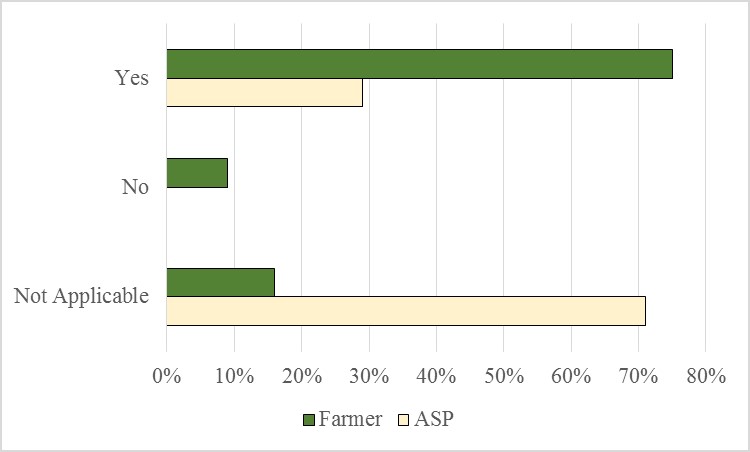
Figure 4. Will this information benefit your operation? (66 responding).
Figure 5. What practices will you implment after attending PAD? (47 responding).
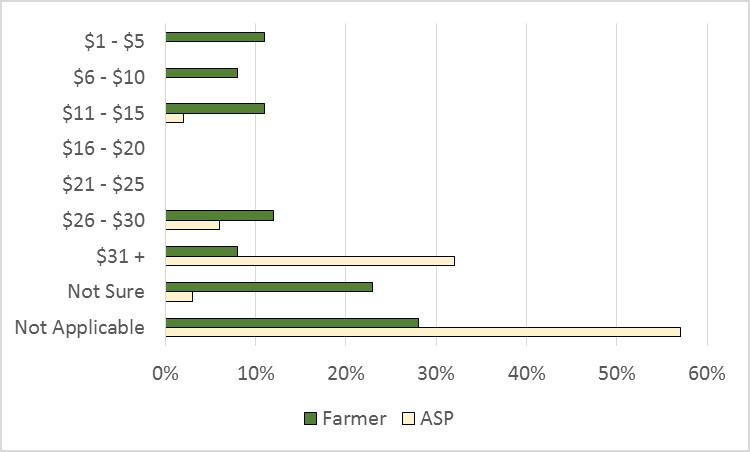
Figure 6. How much do you expect to save after attending PAD? (65 responding).
Agricultural Service Providers Demographics and Response
For those who identified as ASPs at the event, results were also compiled. Part-time farmers were excluded from this group to observe how industry and government benefited from PAD. These individuals found the event to be either good (60%) or excellent (34%).
Self-reporting ASPs were male (68%) and white (92%), although Hispanic/Latino (2%), Black/African American (2%), and other (2%) were also reported (Table 4). There was no dominant age between 25 and 64, but only 5% were over 65 years old. Unlike farmers, ASPs likely retire from their occupation and may no longer be interested in these events. Similar to farmers though, most ASPs had college degrees (55%), with 28% possessing a Master’s degree and 8% with a Doctorate degree (Table 4).
Compared to farmers, a very large amount of ASPs (86%) reported a “very high use” of precision agriculture (Table 1). This may indicate that ASPs either need to be highly versed in these technologies, or at least those ASPs that work in precision agriculture attend PAD. Most ASP’s (71%) reported that information at PAD was not applicable to them (Figure 4). That 70% may represent more government employees and the other 30% as agribusiness attendees. More ASP’s (49%) planned to implement UAV technology after attending PAD (Figure 5). With the legal landscape and costs of UAV equipment, it is also easier for ASP’s to use UAV’s than farmers. There were large savings in cost expected by ASP’s, with 32% reporting they expected to save more than $31/acre after attending PAD (Figure 6).
Prior to attending, ASPs understood the least about UAS (2.4, Table 5) versus other precision agriculture technologies. Following PAD, they reported a similar knowledge level of UAS to other technologies as well as data uses (~3.6, Table 5). All educational categories saw an increase for ASPs. This event needs to educate farmers as well as those who work with them. As observed, ASPs have a high use of precision agriculture technologies, but still maintained PAD held some educational value.
| Farmers | ASP's | |||
| Before | After | Before | After | |
| Average Score (max = 5) | ||||
| UAS | 2.4 | 3.6 | 2.4 | 3.6 |
| Precision Ag Technology | 3.4 | 3.8 | 2.9 | 3.6 |
| Precision Equipment | 3.4 | 3.8 | 2.9 | 3.6 |
| Data and Usage | 3.2 | 3.8 | 2.8 | 3.7 |
Conclusions
To remain viable, Extension Educators must remain in front of trends in agricultural production. As an extension program, PAD may become stale if it doesn’t remain in front of technology. Although it is in its fifth year, PAD has still managed to educate farmers and ASPs in the Mid-Atlantic Region. With an audience that is 27% farmer and 73% ASPs, we also continue to attract a group that is interested and practices precision agriculture. In fact, many of the ASP’s who attend also provide the funding that keeps this event possible.
All attendees reported increases in knowledge in the content areas provided. Many reported an expected increase in savings per acre from the information they learned as well. Those ASP’s who responded to the survey were more likely to use precision agriculture technology and also reported a greater savings from the knowledge gained. Overall, farmers found the information more beneficial, but did not expect as much savings, which may indicate that better examples of cost savings are needed.
Literature Cited
Diekmann, F. & Batte, M.T. (2010). 2010 Ohio Farming Practices Survey: Adoption and Use of Precision Farming Technology in Ohio. (Report Series: AEDE-RP-0129-10). Retrieved from http://www.researchgate.net/publication/281439963_Cost-Effectiveness_of_Greenhouse_Gas_Mitigation_Measures_for_Agriculture_A_Literature_Review
Kitchen, N.R., Snyder, C.J., Franzen, D.W., & Wiebold, W.J. (2002). Educational needs of precision agriculture. Precision Agriculture, 3, 341-351. Retrieved from https://www.ndsu.edu/fileadmin/soils/pdfs/Educ_Needs_of_Prec_Ag.pdf
Mulla, D.J. (2013). Twenty five years of remote sensing in precision agriculture: Key advances and remaining knowledge gaps. Biosystems Engineering, 114 (2013), 358-371. http://dx.doi.org/10.1016/j.biosystemseng.2012.08.009
Walton, J.C., Lambert, D.M., Roberts, R.K., Larson, J.A., English, B.C., Reeves, J.M. (2008). Adoption and abandonment of precision soil sampling in cotton production. Journal of Agricultural and Resource Economics, 33(3), 428-448. Retrieved from http://ageconsearch.umn.edu/bitstream/46556/2/Walton.pdf

